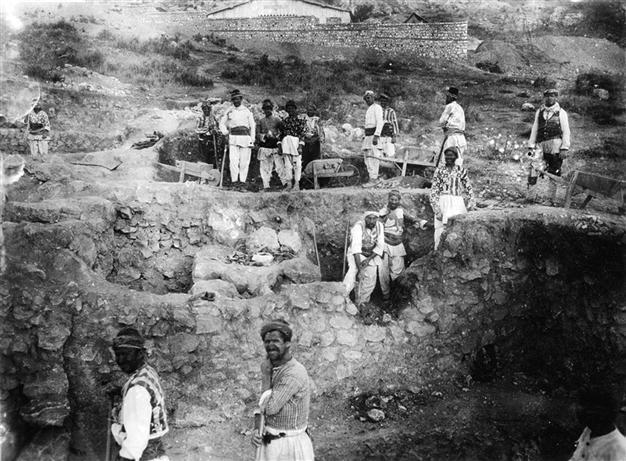History of Hattuşa’s excavation on display
ISTANBUL - Hürriyet Daily News

The exhibtion shows the details of the excavations. There are panels showing a chronological timeline of the excavation chiefs such as Osman Hamdi Bey.
Istanbul’s Yapı Kredi Cultural Center has opened a new exhibition on Hattuşa, inviting viewers to dig through the history of the past 100 years of archaeological excavations at the ancient Hittite capital in northern Turkey.The unpublished photographs that form the backbone of the show were gathered with the aim of painting a historical, ethnographical and sociological panorama of the whole excavations process from 1906 to 2012.
The roots of the show dates back a year ago to when archaeologists and excavation heads working at the German Archaeological Institute (DAI) started to scan an archive of the Hattuşa excavation. The artistic and scientific consultants of the show are DAI archaeologist Jürgen Seeher, the former excavation head at the site in Boğazköy in Çorum, Ayşe Baykal Seeher, as well as the present excavation head, Andreas Schachner. The exhibition opens with an excavation site simulation installed at the entrance. On the right-hand side, the walls in the corridor bear panels showing a chronological timeline of the excavations in the region and introduce the chief archaeologists in charge, like Osman Hamdi Bey, the famous Ottoman Orientalist painter known for his “Turtle Trainer,” as well as the founder of the Istanbul Archaeological Museum.

The discovery of Hattuşa
The name of the Hittites, who established a great empire in Central Anatolia in the second millennium B.C., was almost completely erased from the memory of humanity because their name did not appear in sacred books unlike many civilizations of the ancient Near East. The civilization was partly rediscovered by French researcher Charles Texier, who came to Boğazköy in 1834, publishing the results of the first explorations there in 1839. The plans and drawings in that publication elicited great interest in the archaeological world.
Many explorers and scientists came to Boğazköy for investigations in the 19th century. During these investigations, the first plans of the city were drawn, the first photographs of Boğazköy and Yazılıkaya were taken and several small-scale areas were excavated. Cuneiform tablet fragments, which were sporadically found and brought to Müze-i Hümayun (Royal Museum), as well as the discovery of rock reliefs in Yazılıkaya that were unlike anything known until then, established the existence of an important culture at Boğazköy.
The first traces of settlement in the area of Hattuşa, which has been continuously settled since its

In its northern reaches, the city included a settlement of Assyrian merchants from northern Mesopotamia in the 19th and 18th centuries B.C. It developed like many other Bronze Age cities and shows oft-found characteristics in its architecture and urban layout. The name “Hattush,” which means “silver” in Sumerian, is encountered on cuneiform documents for the first time in this period. The name
of the city is thought to be probably associated with silver trade.
















